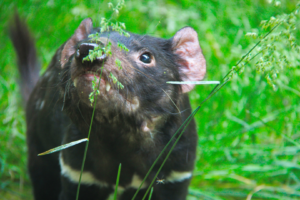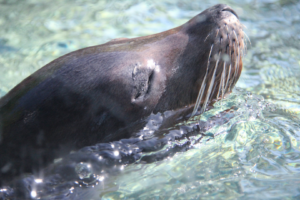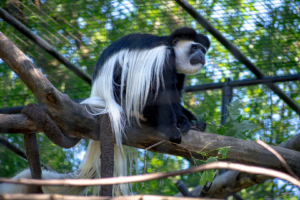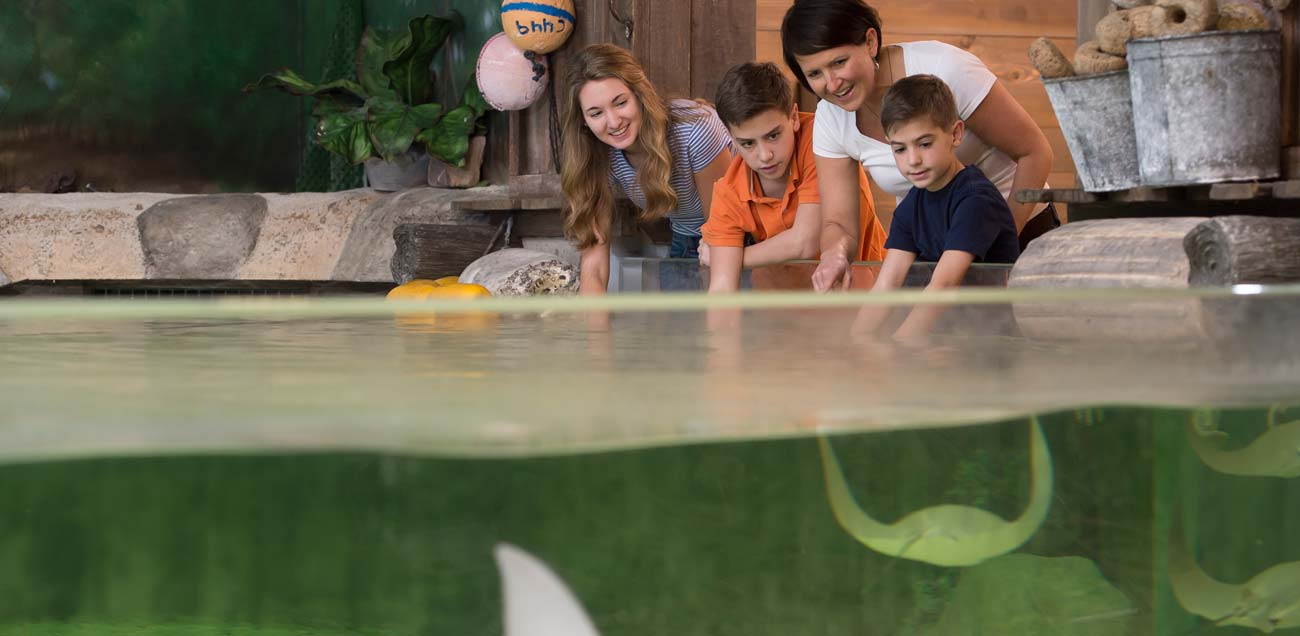The Fort Wayne Children’s Zoo is making a difference for animals every single day. From embracing green practices, to supporting global conservation projects, the Zoo helps to create a healthier planet for all. Use these resources to learn more about our efforts, our conservation partners, and the easy things you can do to help us make a difference.

Kids for Nature Camps
The Fort Wayne Children’s Zoo offers an array of camp opportunities for children through our Kids for Nature Camp Program, including spring, summer, and winter camp sessions. Kids for Nature camp sessions are available for children in PreK through 4th grade (6th grade for summer camp). During these sessions, campers are able to explore the Zoo through animal encounters and behind-the-scenes learning, meet Zoo Keepers and ask questions about what they do, and connect with nature in new and exciting ways.
Kids for Nature Passport
The Kids for Nature Passport is an activity that encourages children to explore outside and have fun while doing it! Spending time in nature helps kids build relationships, expand their creativity, and encourages them to use critical thinking and problem-solving skills. Activities on the Kids for Nature Passport include splashing through rain puddles, finding and smelling different colored flowers, and listening and imitating bird calls. Join the millions of families who recognize that playing outside together is fun! Print your passport here and start earning points. When you get 100 points, turn in this sheet for a prize and one FREE Child Admission Ticket to the Zoo!
Thank you to Steel Dynamics, Inc. for sponsoring our Kids for Nature passport.
![]()
Kids for Nature Kiosk
Just inside the entrance of the Fort Wayne Children’s Zoo sits the Kids for Nature Kiosk, where guests are invited to “vote” for a conservation project of their choice with the penny they are given with their Zoo admission purchase. Additional votes can be made with real quarters, nickels, and dimes, and 100% of any added contributions will go toward the voted project.
The Fort Wayne Children’s Zoo has selected four different conservation projects to be featured at the Kids for Nature Kiosk during the 2024 Season. Visit Our Conservation Partners page to learn about all the conservation organizations the Fort Wayne Children’s Zoo partners with.
Project #1

The kiosk will feature the Save the Tasmanian Devil Program, an organization that works to sustain the endangered Tasmanian Devil populations on the island of Tasmania. Guests will be able to “vote” for and learn about Greening Australia, an independent environmental non-profit that works to protect biodiversity across the Australian continent.
Project #2

Also shown at the kiosk will be the Pacific Marine Mammal Center, who work to rescue and rehabilitate stranded harbor seals and California sea lions.
Project #3

The final conservation project guests will be able to “vote” for is the Pan African Sanctuary Alliance, a coalition of sanctuaries who work together to rescue and rehabilitate monkeys including the colobus monkey, the De Brazza’s monkey, the Schmidt’s red-tailed monkey, and the swamp monkey, all monkey species in the Zoo’s care.
Teens for Nature is a leadership program and an exciting way for students to develop leadership and teamwork skills while exploring the Zoo. Teens will learn, grow, make new friends, and have fun! Depending on the session, teens will have the opportunity to work with children in our Kids for Nature programs, interact with Zoo guests through education activities, participate in conservation projects, or assist Zoo Keepers with daily animal care tasks.
Lesson Plans
Bring animal education to your classroom today! The Fort Wayne Children’s Zoo Education Department has created free lesson plans for teachers PreK through 9th grade to use before, during or after their Zoo field trips, or to supplement classroom activities. Lesson plans cover a variety of topics ranging from African savannah animals to oceanic food chains.
Zoomobile
Bring your science lessons to life with a visit from the Fort Wayne Children’s Zoo! Not only do Zoomobile programs support classroom objectives, but students are also encouraged to develop a deeper understanding of the natural world by asking the Zoo’s dynamic Conservation Educators “I Wonder Why” questions.
ZSI: Zoo Scientific Inquiry
ZSI: Zoo Scientific Inquiry is a cumulative, multi-grade science program where students (grades 3-5) can explore the natural world with hands-on projects and animal encounters.

The Fort Wayne Children’s Zoo supports global conservation projects by partnering with different conservation organizations across the world. By supporting these projects, the Zoo is helping to create a healthier planet for both animals and people. Visit Our Conservation Partners page to learn about all the local and global conservation organizations the Fort Wayne Children’s Zoo partners with.

Did you know that your seafood choices can have a direct impact on the state of the world’s oceans? Purchasing sustainably sourced seafood is one of the most powerful actions you could take to positively impact the ocean. The Monterey Bay Aquarium Seafood Watch® program empowers consumers and businesses to make choices for healthy oceans, helping support diverse marine ecosystems for the future.
As a quick and easy way to make sustainable seafood choices, you can download the Seafood Watch® app or digital seafood guides to make your next trip to the grocery store more sustainable!
One thing you can do from home to positively impact orangutans in the wild is being more intentional about making sustainable palm oil choices. The palm oil industry has greatly impacted Sumatran orangutan habitats and you can help save orangutans by making more sustainable palm oil choices. The Cheyenne Mountain Zoo’s Sustainable Palm Oil Shopping App places this choice right at your fingertips by helping ensure the food products you are shopping for are made with only sustainable palm oil! You can download the Sustainable Palm Oil Shopping App from the iTunes Store or Google Play, or click here for a printable version.

The Fort Wayne Children’s Zoo receives donated firehoses from various organizations, including Fort Wayne Fire Department, the New Haven Fire Department, and the Muncie Fire Department, that are used as enrichment for various animals in our care. Zoo Keepers attend various workshops throughout the year to learn how they can transform the old firehoses into enrichment opportunities. In some enclosures, firehoses are braided together to create feeders to add a bit of a challenge to mealtimes and even firehose hammocks for lounging! In Orangutan Valley, firehoses are used to simulate the vines that a wild orangutans might use to get from one place to another in Sumatra.
Bring your old cell phones and handheld electronics to the Zoo for recycling – you’ll keep harmful substances out of our landfills and help raise money for conservation projects. Most small electronics contain metals that can linger in the environment and have adverse effects on human health. With more than one billion cell phones currently in retirement, there is a huge potential to make a difference!
Coltan, an ore mined in gorilla habitats in the Democratic Republic of the Congo, is used as a coating for components in many cell phones. In recent years, the eastern lowland gorilla populations found there have declined 90%. Reducing the demand for Coltan can help save these endangered animals and their habitat.
Bring any of the listed items below to the Guest Service building at the Zoo entrance any weekday from 8 AM – 5 PM:
Cell phones and cellphone accessories
Digital cameras
iPods and MP3 players
Handheld game systems
GPS handheld units
Laptops
E-readers
Portable hard drives
Chargers for any of the devices above
PLEASE DO NOT BRING desktop computers, monitors, DVD players, VCRs, or TVs.
Every holiday season, the Fort Wayne Children’s Zoo collects used and broken holiday lights to prevent them from ending up in a landfill, something that can cause toxic chemicals to leach into the soil and water. With the help of the community, each year the Zoo diverts upwards of 1,000 pounds of lights from the landfill.
The Fort Wayne Children’s Zoo partners with the Allen County Solid Waste Management District to reduce the amount of waste entering our landfills. When visiting the Zoo, guests are encouraged to place aluminum cans or plastic beverage bottles in blue recycling bins found throughout their visit. Each year, the Zoo recycles thousands of tons of cardboard, steel cans, office paper, and plastic.
Each year, more than 200 tons of organic material (such as straw, wood shavings, and animal waste) is hauled to Fort Wayne’s Biosolids Handling Facility, where it is turned into compost, rather than buried in the landfill. The Zoo’s Resource Conservation Task Force is comprised of employees working to identify opportunities to reduce energy use, raise awareness, and save money.
In March of 2014, crews installed a storm water quality unit under the Zoo’s main parking lot, something that helps keep debris and waste out of the local watershed. The Zoo received the 2014 Excellence in Recycling award from the Allen County Solid Waste Management District. A portion of the Zoo has also been designated as a “No Mow Zone.”
The Fort Wayne Children’s Zoo is a Bright Green Certified Business, meeting the requirements set by the Northeast Indiana Sustainable Business Council for cost-saving, energy-reduction, and Earth-friendly practices. At the time of certification in 2010, the Zoo was just the 32nd business in Fort Wayne to achieve this distinction and the very first park to do so. The Zoo was named Sustainable Business of the Year in 2014 by the Northeast Indiana Sustainable Business Council.

Each year, the Fort Wayne Children’s Zoo participates in Plastic Free July EcoChallenge, and we invite both Zoo staff and members of our community to participate. Plastic Free July is a global campaign that encourages people to cut down on their plastic use and live more sustainably. This movement aims to reduce the global usage of single-use plastics like straws, plastic baggies, and plastic water bottles.
The Fort Wayne Children’s Zoo is a non-profit organization and one of the few zoos in the country that does not receive government funding or tax dollars to operate. Our efforts would not be possible without your support as we rely heavily on our on our guests, members, and generous donations to bring our mission to life! To make a donation to the Fort Wayne Children’s Zoo, please click the Support our Mission tile below.

























